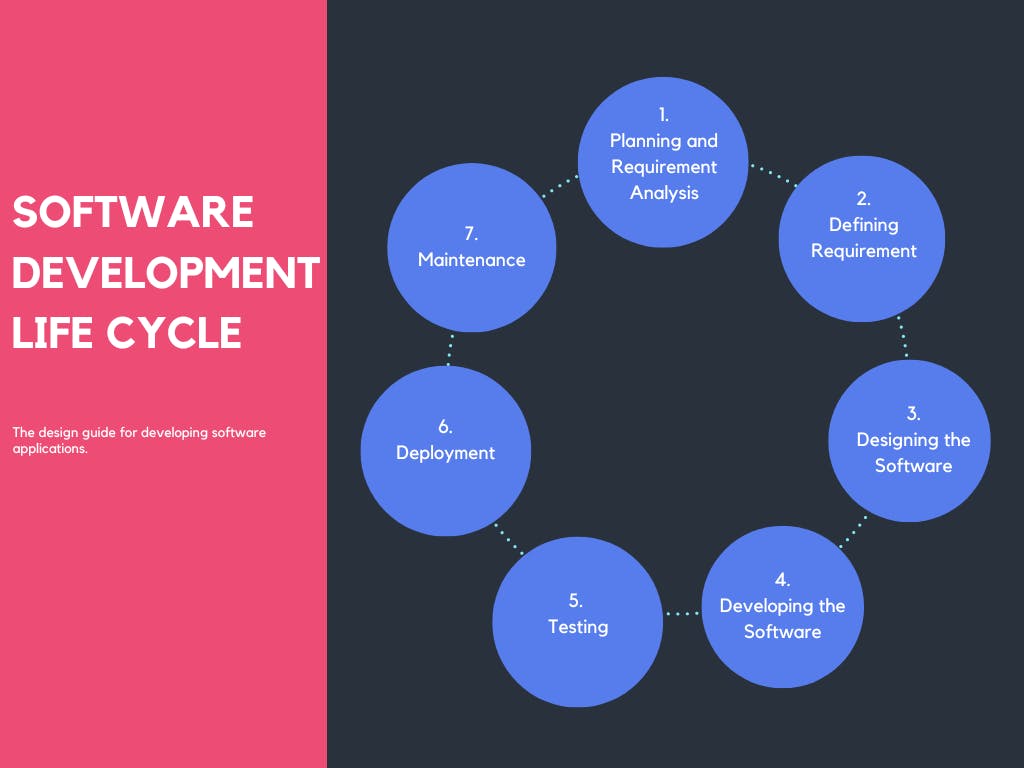Developers, especially newbies who may have heard of the "software development life cycle" but haven't taken the time to understand or implement it, may find this terminology a little odd. Today, we'll go deeper into the Software Development Life Cycle and discuss its significance for software engineers.
What is SDLC?
First off, software development according to IBM is referred to as a set of computer science activities dedicated to the process of creating, designing, deploying, and supporting software.
Software Development Life Cycle is a design guide for developing software applications. Software development follows a precise, step-by-step procedure. The SDLC contributes to the rapid development and cost-effective delivery of high-quality software to end users.
The Software Development Life Cycle (SDLC) approach is important because it is used by the software industry to plan, design, develop, test, and maintain high-quality software. The goal of the SDLC is to create high-quality software that meets or exceeds customer expectations while finishing on schedule and under budget.

Stages of SDLC
There are 7 major stages involved in software development and they are:
Planning and Requirement Analysis
This stage can also be referred to as the feasibility stage. This is the stage where problems are identified, objectives are defined, information regarding the proposed or intended software is collected and examined, and cost and resource estimation for the software is carried out.
Defining Requirement
The proposed software requirements are described at this point. The SRS(Software Requirement Specification) document is created by the software engineer. This document is extremely important since it outlines the tasks that must be completed throughout the software life cycle, including the software definition and the tools and hardware that must be used for software implementation. At this point, prototype concepts are also considered.
Designing the Software
The software designs will then be constructed in accordance with the SRS's criteria, and one will be selected based on its viability and logicality. A detailed Design Specification Document (DSS), which includes all the design requirements, is created at this stage. Once the design is approved, the team gets to work.
Developing the software
This is the stage where the main development of the software begins, where the codes are written. To have a thorough grasp of what they are developing, how to approach it, and the tools or frameworks to utilize while building it, software engineers turn to the SRS and DSS.
Based on the requirements and proposed use of the software, the programming language to be used is chosen, and the tools for debugging and compiling the software program are done. Organizations typically establish protocols or standards, and software engineers must make sure they adhere to these protocols while creating the program.
Testing
This phase of software development is extremely important. The software is tested once it has been developed to make sure it is stable and provides a positive user experience. The SRS document serves as a standard against which the software's final output is evaluated to ensure that it complies with requirements.
Software testers test software when developed to find bugs in the software that needs fixing.
Deployment and Documentation
This is the act of releasing or launching the product/software into the market for consumers' use. The software is at this point ready for end users to use and operating in production mode. The art of documentation is to convey as much information as you can about a product in a clear, simple manner. This is highly helpful when developing software since it makes it easier for visitors to traverse the website and utilize the software product effectively and error-free.
Maintenance
After the product is launched into the market, it will require regular updates and maintenance as software/tools sometimes become outdated and new issues might come up when different users start using the software. The software engineer or development team is charged with the responsibility of maintaining the software product.
How do I implement SDLC to projects as a beginner developer?
Beginners developers might find this concept of SDLC complex but it's not and in a small way must have implemented it while starting a project, big or small. Here is an illustration of how it can be implemented by a newbie front-end developer.
Deciding to work on a front-end project, a real-estate web application for example. Researching users' past experiences/problems while navigating existing real estate websites.
Defining what the real-estate app requires to set it out from other real-estate apps out there. Tools, and frameworks(Javascript framework, CSS framework) to be utilized while building this web app are decided on. Listing out all the requirements of the web app.
Selecting from a wide variety of real-estate designs from Figma, dribble, or any other design site. Adding to the chosen design, other features you think would be cool to incorporate into the web app.
This is where the main work of coding is done. Bringing the design to life using programing language and frameworks if necessary.
Testing the web app on all devices' screen sizes to ensure responsiveness and using testing libraries. Sending out a beta version of the app to close friends or mentors to check out and leave reviews or give corrections.
Hosting and deploying the web application on GitHub pages, Netlify, Vercel, or whichever one the developer is comfortable using. Documenting your work process to help others who'd want to make use of your web app or who might want to learn from it.
After deployment, check your website or web app frequently to make sure it is still functioning as it should and to add any new, enhanced features.
Understanding the life cycle of software development is very important to software developers as it gives a detailed view of how the project is expected to go, from the planning stage to the deployment and maintenance stage. This helps developers prepare ahead for the project in terms of software tools to use, debugging, and compiling tools. I hope this serves as a reminder for developers to begin adopting the software development life cycle rather than diving right into programming if they haven't already.
